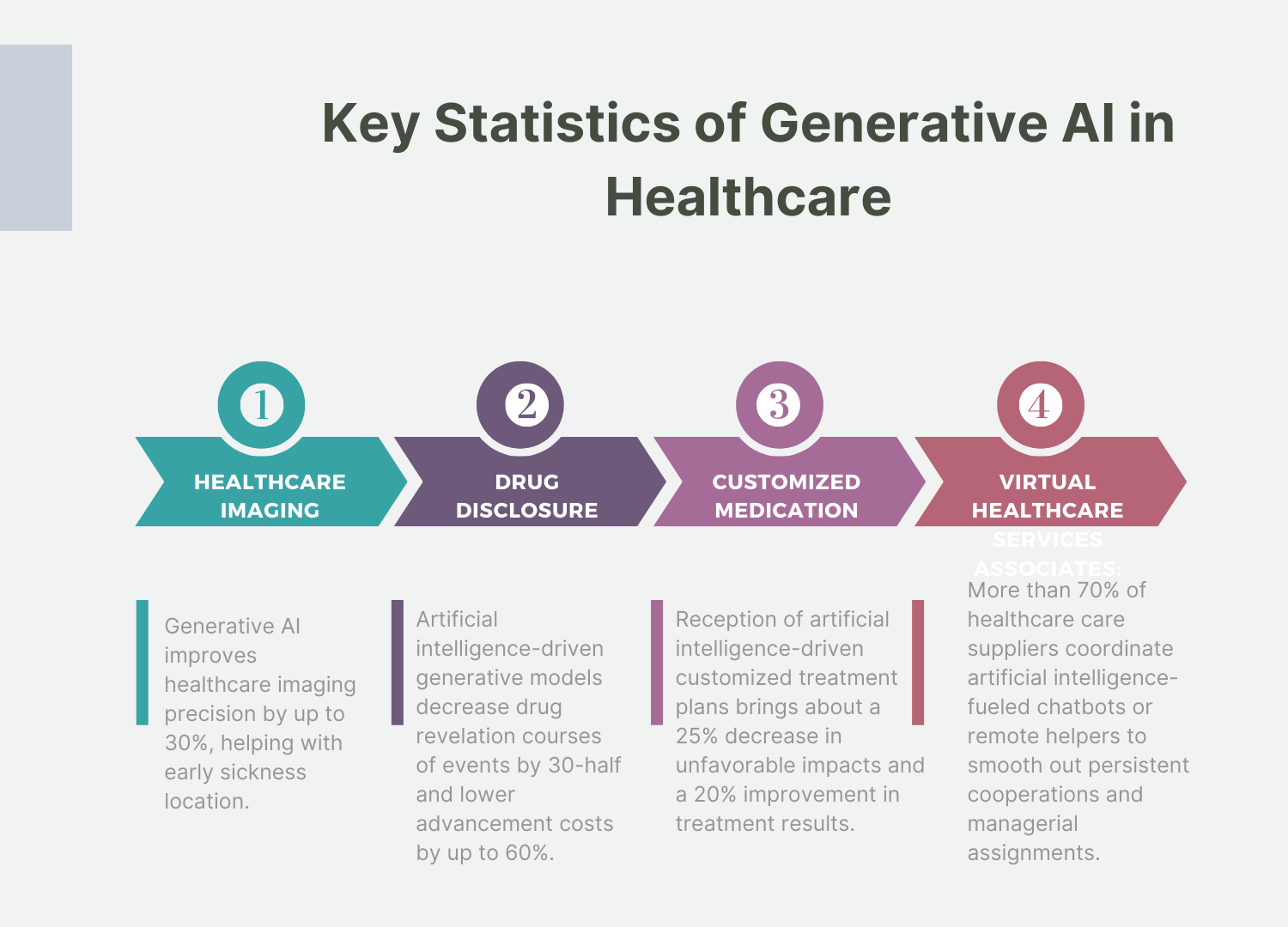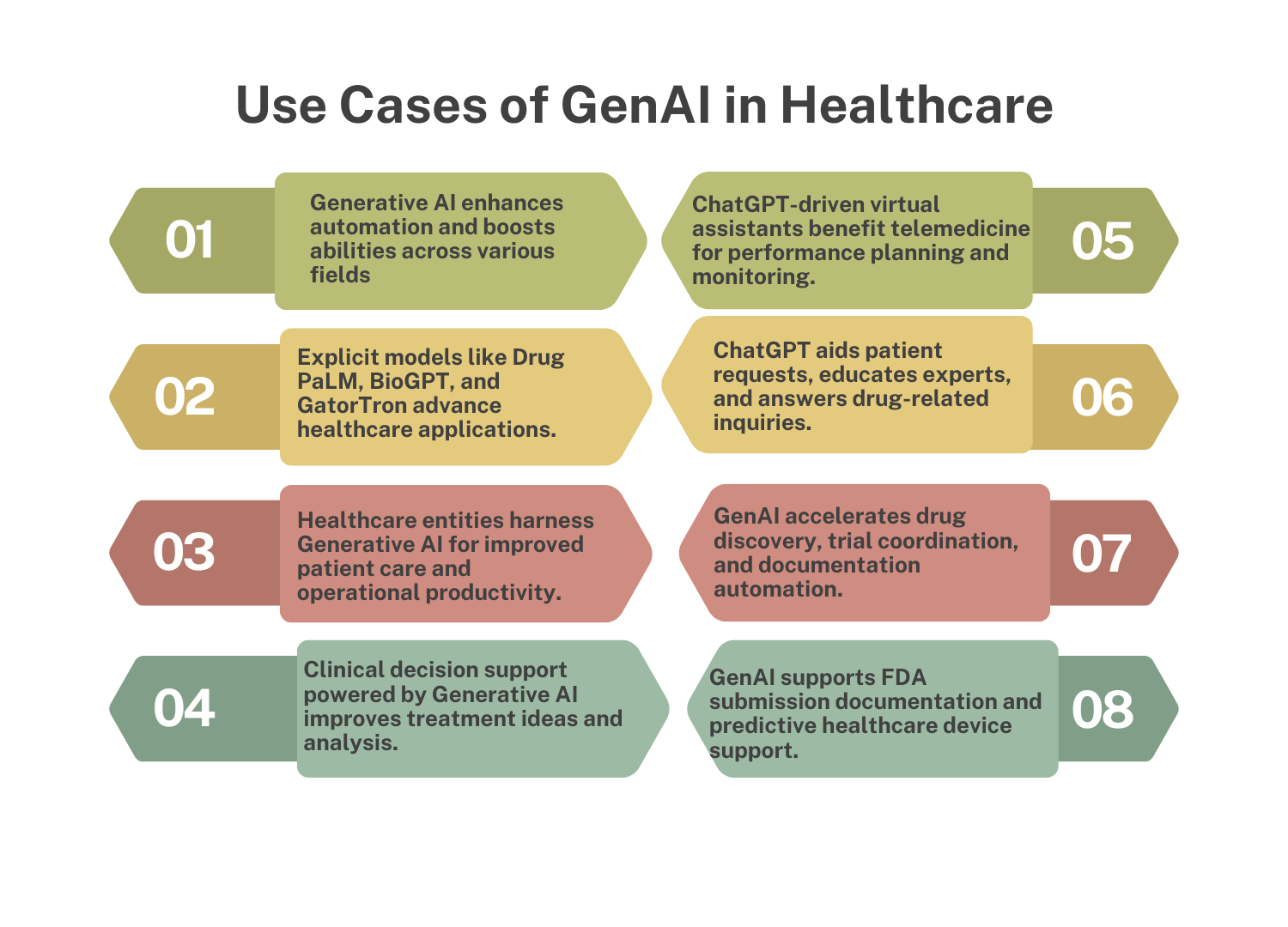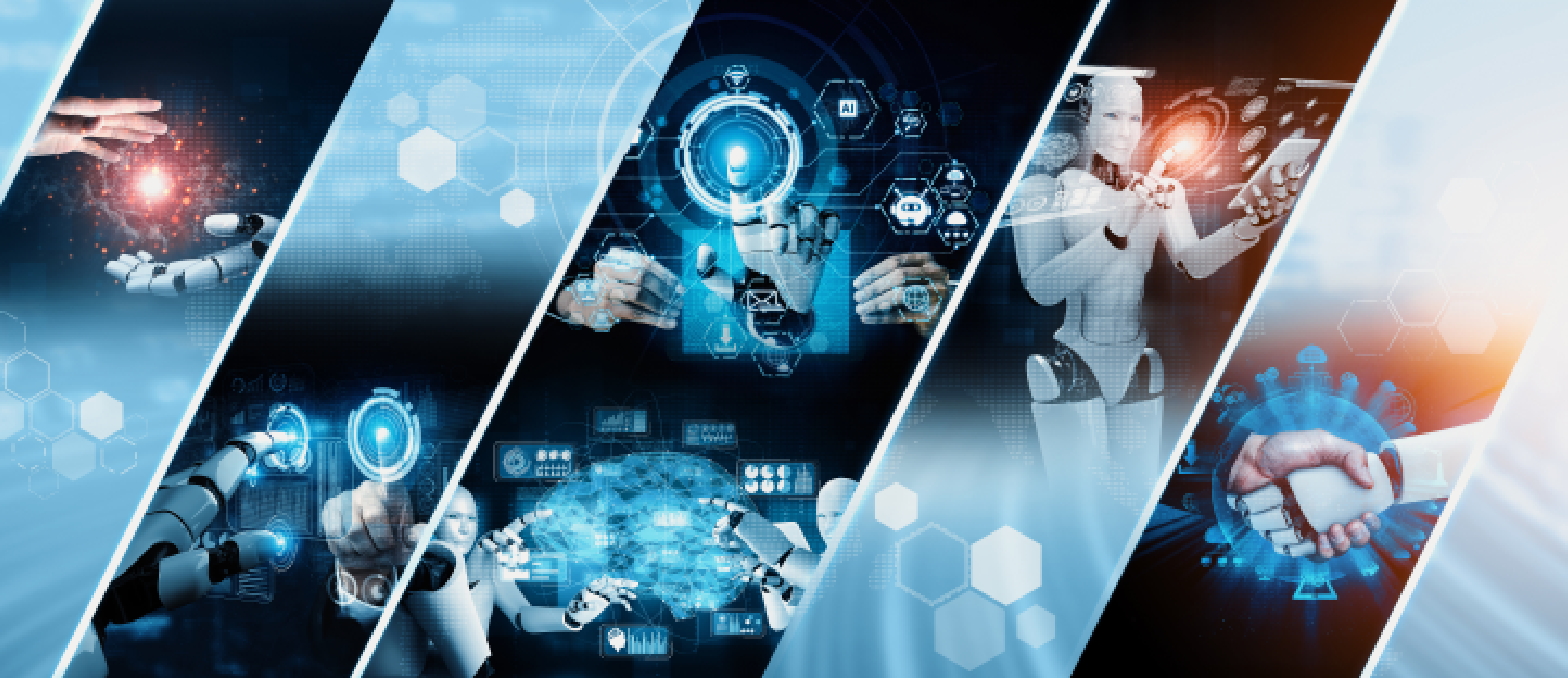Table of Contents
Generative AI can transform the healthcare services industry by breaking down healthcare data and making more exact decisions. This assists with giving a significant area of progress concerning Generative AI services. This article discusses the present status of Generative AI in healthcare, its possible advantages, and difficulties.
The Coronavirus pandemic uncovered basic healthcare care difficulties, including a deficiency of healthcare care laborers. The World Health Organization predicts a deficit of 15 million healthcare services laborers by 2030. To address this, specialists, analysts, and business visionaries are going to artificial intelligence to upgrade healthcare services.
In 2021, generative AI companies got almost $10 billion in revenue, with more than $3 billion at the beginning of 2022. These innovative organizations are revolutionizing healthcare care through developments like X-rays and Cancer treatments, reshaping how millions access healthcare consideration.

What is Generative AI: An Overview of the Disruptive Technology
Generative AI models remain at the bleeding edge of technological development, transforming different businesses with momentous capacities. This state-of-the-art innovation incorporates systems fit for producing new impersonating human-like ways of behaving and making results like pictures, text, music, etc. At its center, Generative AI in Healthcare spins around machines gaining designs from huge datasets and utilizing this data to deliver unique substance.
How Generative AI Functions?
Generative AI uses brain organizations, particularly Generative Ill-disposed Organizations (GANs) and Variational Autoencoders (VAEs). GANs comprise two brain organizations — generative and discriminative — which work as a couple. The Generative AI technology makes new data, while the discriminative organization assesses the realness of that data. This interaction drives the generative cycle, working on the nature of produced content over the long run.
Explore the Power of Generative AI By Partnering With Us
Uses of Generative AI
1. Workmanship and Plan
- Making workmanship pieces, plans, and illustrations.
- Aiding innovative strategies for creators and craftsmen.
2. Content Age
- Delivering practical text, including articles, stories, and verse.
- Producing interactive media content like pictures, recordings, and music.
3. Healthcare services
- Generative AI healthcare imaging and symptomatic analysis.
- Drug revelation and subatomic plan.
4. Gaming and Entertainment
- Producing game environments, characters, and accounts.
- Upgrading client encounters through customized content.
5. Money and Business
- Extracting location and chance appraisal.
- Estimating market drifts and improving business techniques.
Key Components of Generative AI
Generative AI contains a few key parts, and the collaboration between these assumes a crucial part in its usefulness and development.
1. Natural Language Processing (NLP):
Role in Generative AI:
NLP services focus on empowering machines to comprehend, decipher, and produce human language. In Generative AI, NLP algorithms are urgent for producing text-based content, including articles, stories, and discourse.
These algorithms break down and decipher literary data, permitting artificial intelligence models to fathom sets, punctuation, semantics, and grammar to produce reasonable and logically important products.
Applications in Generative AI:
– Text: Making human-like text, chatbots, and discourse systems.
– Opinion analysis: Grasping feelings and sentiments in message data.
– Language Interpretation: Working with exact language interpretation in artificial intelligence-created content.
2. AI (ML):
Role in Generative AI:
ML shapes the groundwork of generative models, empowering machines to gain from data and make forecasts or produce new satisfactory results.
Inside artificial intelligence services, ML algorithms are prepared on huge datasets to perceive examples and probabilities, permitting models to create content that copies human-like results.
Applications in Generative AI:
– Picture and Video Age: ML-based models produce pictures and recordings in light of learned designs.
– Proposal systems: ML models create customized proposals by examining client conduct and inclinations.
– Music and Workmanship Age: Making new music solutions or imaginative products.
3. Deep Learning (DL):
Role in Generative AI:
Deep Learning is a subset of ML that includes brain networks with different layers to comprehend and handle complex examples in data. In Generative AI, DL structures like generative adversarial networks (GANs) and Variational Autoencoders (VAEs) assume an essential part. GANs, for example, comprise generator and discriminator networks that work adversarially to make new satisfied while working on their quality.
Applications in Generative AI:
– GANs: Creating reasonable pictures, recordings, and different media.
– VAEs: Making assorted and organized yields, similar to countenances or scenes, by learning inert portrayals.
Synergy Between Components:
NLP, ML, and DL synergize to upgrade Generative AI abilities. For example, NLP methods joined with DL models empower more modern text age, permitting artificial intelligence systems to deliver logically pertinent and lucid language. ML algorithms gain from tremendous datasets, and when coordinated with DL structures, they work on the quality and variety of produced content.
The joined force of NLP for language processing, ML for design acknowledgment, and DL for complex data handling enables Generative AI to mimic human-like inventiveness and critical thinking. The generative AI company collaborates between these parts and keeps on propelling the limits of what artificial intelligence can produce, setting out new open doors across different businesses and spaces.
Revolutionizing Healthcare through Generative AI
Generative AI is proclaiming an extraordinary time in healthcare services, reshaping diagnostics, therapy plans, drug revelation, and patient consideration. Its capability to break down immense datasets, produce engineered data, and recreate complex organic systems is altering the business, further developing productivity, exactness, and patient results.
Indicative Progressions:
Generative AI plays a vital part in healthcare imaging understanding. Its capacity to examine and produce pictures helps with early sickness discovery and exact determination. For example, Profound Learning-based generative models help radiologists in distinguishing anomalies in X-beams, X-rays, and CT examines with more prominent accuracy, improving demonstrative precision and facilitating treatment.
Drug Revelation and Improvement:
The course of medication disclosure, generally a tedious and costly undertaking, benefits monstrously from Generative AI. Machine learning-driven generative models break down subatomic designs, foresee compound connections, and mimic medication reactions, speeding up the distinguishing proof of potential medication applicants. This assists the disclosure of new treatments and works with customized medication.
Customized Treatment Plans:
Generative AI in Healthcare empowers the formation of customized therapy plans by examining patient data, including healthcare history, hereditary data, and treatment reactions. By incorporating these bits of knowledge, artificial intelligence models create custom-made treatment choices, streamlining care and working on understanding results while diminishing antagonistic impacts.
Patient Consideration and Checking:
In healthcare services, artificial intelligence-fueled chatbots and menial helpers work with patient connection, offering nonstop help, noting questions, and offering healthcare direction. These artificial intelligence-driven tools by Artificial intelligence solutions companies upgrade patient commitment, smooth out authoritative assignments, and give ideal help, further developing general healthcare care openness.
Elevate Your Projects With Our Generative AI Expertise
Benefits of Using GenAI in Healthcare
Generative AI (GenAI) presents a large number of advantages in changing healthcare services, offering extraordinary solutions that upgrade diagnostics, therapy procedures, patient consideration, and general functional proficiency.
1. Accuracy Diagnostics:
Generative AI in Healthcare altogether improves analytic exactness in healthcare imaging translation. Studies have demonstrated that artificial intelligence-based systems, utilizing generative models, further develop exactness rates by up to 30% in distinguishing irregularities in radiology filters, such as X-beams, X-rays, and CT examines. This accuracy supports early infection discovery, prompting convenient mediation and working on persistent results.
2. Sped-up Medication Disclosure:
The use of GenAI assists the medication disclosure and advancement process. By utilizing AI and generative models, analysts can foresee compound connections, mimic medication reactions, and recognize potential medication competitors all the more quickly.
This approach lessens drug disclosure timetables by 30-half and brings improvement costs down to 60%, altogether affecting the accessibility of new treatments.
3. Customized Treatment Methodologies:
GenAI works with the production of customized therapy plans by examining different patient data collections, including hereditary data, healthcare history, and treatment reactions. The combination of these bits of knowledge empowers artificial intelligence models to produce custom-fitted treatment choices. Reception of artificial intelligence-driven customized treatment plans has shown a 25% decrease in unfavorable impacts and a 20% improvement in treatment results.
4. Upgraded Patient Care:
Artificial intelligence-driven tools, for example, chatbots and remote helpers controlled by Generative AI, improve patient consideration by offering ceaseless help, noting inquiries, and offering healthcare direction.
More than 70% of healthcare services suppliers coordinate artificial intelligence-fueled devices to smooth out persistent communications, lessen managerial weights, and guarantee convenient help, further developing Generative AI in Healthcare services.
5. Telemedicine advancements:
Telemedicine, reinforced by GenAI, has seen critical advancements. Far-off quiet checking and artificial intelligence-empowered diagnostics work with healthcare services deliverance past conventional healthcare care settings.
This approach empowers more productive distribution of assets, stretches out healthcare benefits to far-off regions, and further develops admittance to healthcare care, particularly in underserved networks.
6. Factual Insights:
- The worldwide artificial intelligence in the Healthcare market is projected to outperform $67.4 billion by 2027, exhibiting the fast reception and development of artificial intelligence-driven advances in the healthcare area.
- Artificial intelligence-controlled devices are assessed to lessen healthcare care costs by up to half while working on quiet results, as detailed by a few analyses.
Future Possibilities:
Generative AI technology keeps on developing, driven by advancements in artificial intelligence algorithms and the accessibility of huge healthcare datasets. A joint effort between artificial intelligence consultants, healthcare services experts, and administrative bodies is vital for enhancing artificial intelligence’s true capacity while guaranteeing moral practices, patient protection, and administrative consistency.
GenAI’s direction in healthcare is ready to reclassify healthcare practices, fuel development, and further develop healthcare services deliverance on a worldwide scale. As artificial intelligence innovations keep on propelling, their effect on healthcare services vows to reform patient consideration, improve asset use, and at last upgrade health results for populaces around the world.
Use Cases of GenAI in Healthcare
Generative AI opens up the chance for a lot of new use cases for different organizations to robotize, increase, and improve manual cycles and subsequently assist with further developing client experience and representative efficiency. A few organizations are likewise creating healthcare services and healthcare space explicit models, for example, Drug PaLM from Google, BioGPT, healthcareBERT, and GatorTron from the College of Florida and Nvidia. These models are prepared in the Healthcare services space to give exact responses to the inquiries.
Healthcare services, Pharma, and healthcare devices organizations are assessing the innovation and investigating business use cases to apply this innovation as there is an enormous potential for Generative AI to assist with working on quiet consideration and experience, healthcare independent direction, diminish healthcare software development services proficiency responsibility, accelerate healthcare exploration and improve functional effectiveness.
Medical Note-Taking
Generative AI can smooth out and robotize the healthcare note-taking cycle by catching the vital realities from patient discussions and summing them up as doctors’ notes in Electronic Health Records.
It can likewise be utilized to sum up and make healthcare notes, for example, visit synopses, release notes, radiology reports, or pathology reports. The machine learning solutions can likewise improve complex healthcare language into rundowns and interpret them into any language so patients can see without any problem.
Clinical Decision Support
Generative AI can help specialists and healthcare experts make exact and informed analyses and propose therapy choices by breaking down data from a patient’s healthcare records, lab results, past therapies, and healthcare imaging, like X-rays and X-beams. It can likewise help in quiet schooling by addressing questions connected with sickness and therapy.
Telemedicine and Remote Patient Monitoring
ChatGPT-based remote helpers can assist patients with booking solutions, getting treatment, and dealing with their health data. It can likewise be utilized to screen patients from a distance by examining data from wearables, sensors, and other checking devices, giving continuous experiences into a patient’s health status to healthcare services suppliers.
Medical Data and Education
Patients can speak with ChatGPT utilizing regular language and pose inquiries connected with drugs, including dose, incidental effects, and communications. ChatGPT can likewise furnish understudies and healthcare services experts with moment admittance to the most recent exploration, rules, and practices, accordingly supporting their continuous learning and advancement.
Drug Discovery and Development
The utilization of GenAI can speed up the medication revelation and advancement process. Via looking through the healthcare and logical writing on sites, like PubMed or healthcaretrials.gov, potential medication up-and-comers can be distinguished and tried for adequacy utilizing programmatic experiences (in silico) before continuing to Generative AI preliminaries on creatures and people.
GenAI can plan healthcare preliminaries and creator convention archives. It can likewise make healthcare review reports by producing synopses of healthcare preliminaries, including the review plan, patient attributes, adequacy and health results, and measurable analysis. This can altogether lessen the time and exertion expected to physically aggregate this data.
Healthcare device submission
GenAI can be utilized to consequently make vital Premarket Endorsement (PMA) applications or Premarket Notice 510(k) documentation for FDA Accommodation. It can likewise be possibly utilized for making naming documentation.
By examining data from healthcare devices, for example, imaging hardware or ventilators, GenAI algorithms can predict when upkeep is fundamental. This can assist healthcare care suppliers with enacting their production network processes before proactively keeping up with their gear and lessen the gamble of hardware disappointment.
Synthetic Medical Data
GenAI can assist with creating manufactured patient-level healthcare data that is sensible to prepare AI models without the gamble of uncovering private data about genuine patients.

The Flip Side of Generative AI- Challenges and Risks
Generative AI (GenAI) offers groundbreaking expectations in different spaces, yet its arrangement likewise presents eminent difficulties and dangers that require conscious thought.
Moral and Predisposition Concerns:
1. Predisposition in data and algorithms:
GenAI depends vigorously on preparing data, which can convey inborn predispositions, prompting one-sided results. If preparing datasets are unrepresentative or slanted, artificial intelligence models can sustain predispositions, influencing choices in healthcare services, finance, and other basic spaces.
2. Moral Utilization of Artificial Intelligence:
Keeping up with moral principles in artificial intelligence advancement and sending is urgent. Questions emerge regarding artificial intelligence’s dynamic straightforwardness, responsibility, and expected moral issues, particularly in basic areas like healthcare care, where artificial intelligence-driven choices influence lives.
Protection and Security Dangers:
1. Patient Data Protection:
The utilization of touchy patient data in artificial intelligence applications raises worries about security breaches and data abuse. Safeguarding patient classification and guaranteeing consistency with data security guidelines are fundamental.
2. Cyber Security Risks:
Dangers like ill-disposed assaults on artificial intelligence models, data breaks, and artificial intelligence-created counterfeit substances present dangers to system respectability and client trust.
Administrative Difficulties:
1. Developing Administrative Structures:
The fast speed of artificial intelligence progressions dominates administrative structures, bringing about difficulties in laying out normalized rules and solutions to oversee artificial intelligence’s capable use.
2. Consistency Necessities:
Guaranteeing consistency with existing guidelines, like healthcare data insurance regulations (e.g., HIPAA), becomes mind-boggling as artificial intelligence-driven systems develop and produce different results.
Innovative Impediments:
1. Absence of Interpretability:
GenAI models, especially complex profound learning designs, need interpretability. This can comprehend how artificial intelligence shows up at explicit choices or results, restricting their reasonableness.
2. Overfitting and Speculation:
Artificial intelligence models could overfit in preparing data, bringing about high precision inside the preparation set yet decreasing execution in certifiable situations, affecting their generalizability.
Human Labor Force Effect:
1. Work Dislodging:
Computerization through artificial intelligence, including Generative AI, can supplant specific work capabilities, prompting labor force removal and the requirement for reskilling or upskilling.
2. Reliance on artificial intelligence:
Overreliance on artificial intelligence systems could lead to human reliance on innovation, possibly sabotaging decisive reasoning and critical thinking abilities.
Tending to Difficulties:
1. Inclination Alleviation:
Tending to predisposition in artificial intelligence requires different, delegated datasets, progressing observing, and vigorous predisposition relief techniques to guarantee fair and unprejudiced artificial intelligence results.
2. Moral Rules:
Laying out clear moral rules and structures for artificial intelligence advancement and sending advances capable of artificial intelligence use, straightforwardness, and responsibility.
3. Protection and Safety efforts:
Carrying out strong encryption, data anonymization methods, and tough network safety conventions shields sensitive data and mitigates online protection gambles.
4. Administrative Structures:
Cooperation between policymakers, industry specialists, and partners is essential to foster versatile and complete administrative systems that oversee artificial intelligence innovations.
5. Straightforwardness and Instruction:
Improving artificial intelligence straightforwardness, and logic, and teaching partners about artificial intelligence’s abilities, limits, and moral contemplations cultivate trust and capable artificial intelligence reception.
The Future of Gen AI in Healthcare
The fate of Generative AI holds colossal commitment, ready to reform patient consideration, diagnostics, drug improvement, and by and large Generative AI services deliverance. A few patterns and measurements shed light on the direction of Gen AI in healthcare software development services :
Advancements in Medical Imaging:
– Factual Insight:
Artificial intelligence-based healthcare imaging is projected to develop at a CAGR of more than 10% by 2027, driven by Gen AI’s capacities in working on symptomatic exactness and productivity.
– Future Projection:
Gen AI will keep improving healthcare imaging understanding, helping radiologists in distinguishing unpretentious irregularities, in this way empowering early sickness identification and exact therapy arranging.
Customized Medication and Treatment:
– Factual Insight:
The market for customized medication is supposed to surpass $3 trillion by 2025, to a great extent powered by Gen AI’s Role in examining patient data for custom-made treatment systems.
– Future Projection:
Gen AI’s ability to break down immense patient datasets, including hereditary qualities and treatment reactions, will empower the formation of customized treatment plans, advancing treatments and limiting unfavorable impacts.
Drug Revelation and Improvement:
– Factual Insight:
The artificial intelligence in the drug revelation market is estimated to reach $3.5 billion by 2027, basically determined by Gen AI’s capacity to facilitate drug advancement processes.
– Future Projection:
Gen AI-driven reenactments and prescient displaying will speed up drug disclosure by distinguishing possible competitors, decreasing courses of events, and improving accuracy in drug plans.
Remote Patient Monitoring and Telemedicine:
– Factual Insight:
Telemedicine reception is expected to develop at a CAGR of more than 16% by 2027, enabled by Gen AI’s capacities in distant patient observing and diagnostics.
– Future Projection:
Gen AI-empowered telehealth solutions will expand healthcare care administrations past conventional settings, working with far-off diagnostics, nonstop persistent checking, and further developing healthcare services openness.
Moral Contemplations and Guideline:
– Factual Insight:
More than 80% of Generative AI service providers recognize the requirement for strong artificial intelligence administration and guidelines, perceiving Gen AI’s effect on quiet results and data security.
– Future Projection:
There will be deliberate work to lay out complete moral rules and administrative structures overseeing Gen AI in healthcare services, guaranteeing capable use, patient security, and data security.
Coordinated effort and Incorporation:
– Factual Insight:
Industry joint efforts between tech organizations, healthcare services suppliers, and exploration foundations are seeing a flood, connoting a consolidated work to use Gen AI’s true capacity.
– Future Projection:
Coordinated efforts will zero in on coordinating Gen AI into healthcare work processes, encouraging interdisciplinary methodologies, and driving advancements in diagnostics, medicines, and patient consideration.
The future scene of Gen AI is described by its unavoidable reconciliation into different features of healthcare care deliverance. As innovation develops, Gen AI’s effect will be extraordinary, advancing patient results, driving accurate medication, and reshaping the healthcare services ecosystem toward more customized, productive, and open consideration.
Proceeded with progressions, moral contemplations, and administrative structures will be instrumental in harnessing Gen AI’s maximum capacity while guaranteeing its dependable and impartial organization in healthcare care.
Ignite Innovation in Your Healthcare Services With Our Generative AI Solutions
Final Thoughts
- The results of the Deloitte survey mirror those from a purchaser survey delivered recently. A review from Medtronic and Morning Consult tracked down that the greater part (51%) of U.S. grown-ups are hopeful new applications of artificial intelligence will lead significant advancements and leap forward in healthcare services in the year ahead.
- Probably the most significant levels of optimism for Generative AI in Healthcare are around analysis and further developing healthcare access. About 6 of every 10 adults (61%) agree one of the primary advantages of involving healthcare is to analyze and recognize health conditions.
- Around 66% of grown-ups agree technology can assist separate obstructions to healthcare with the greater part (56%) saying AI (explicitly) can be advantageous in further developing healthcare access, the Medtronic survey found.
- Consumers have a great potential of utilizing AI to deal with their health yet report they aren’t prepared for their doctor to widely utilize it. Just about 36% say they would like to work with a doctor who utilizes AI, and just 1 of every 5 (20%) would believe their primary care physician should utilize AI widely.
However, when given explicit ways a doctor could utilize AI, Americans are more open
- 67% say they’d probably work with a doctor who utilizes AI to examine tests, X-rays, and CT Scans. The greater part says something similar for recognizing disease (62%).
“While skepticism is natural, the survey found strong optimism around the potential of AI in healthcare. And the reality is, the way we engage with AI will likely look radically different five to 10 years from now. That said, there is one thing I’m certain of—the responsible, ethical use of AI has the power to radically improve healthcare for both patients and doctors,” Ken Washington, chief technology and innovation officer at Medtronic, in a statement.
Here’s the bottom line—AI can’t be a substitute for human judgment and experience. he said. ” To this end, we can’t imagine a future where artificial intelligence will replace doctors. However, we can imagine a future where Generative AI in Healthcare is universal, creating better experiences and outcomes that patients will prefer.






